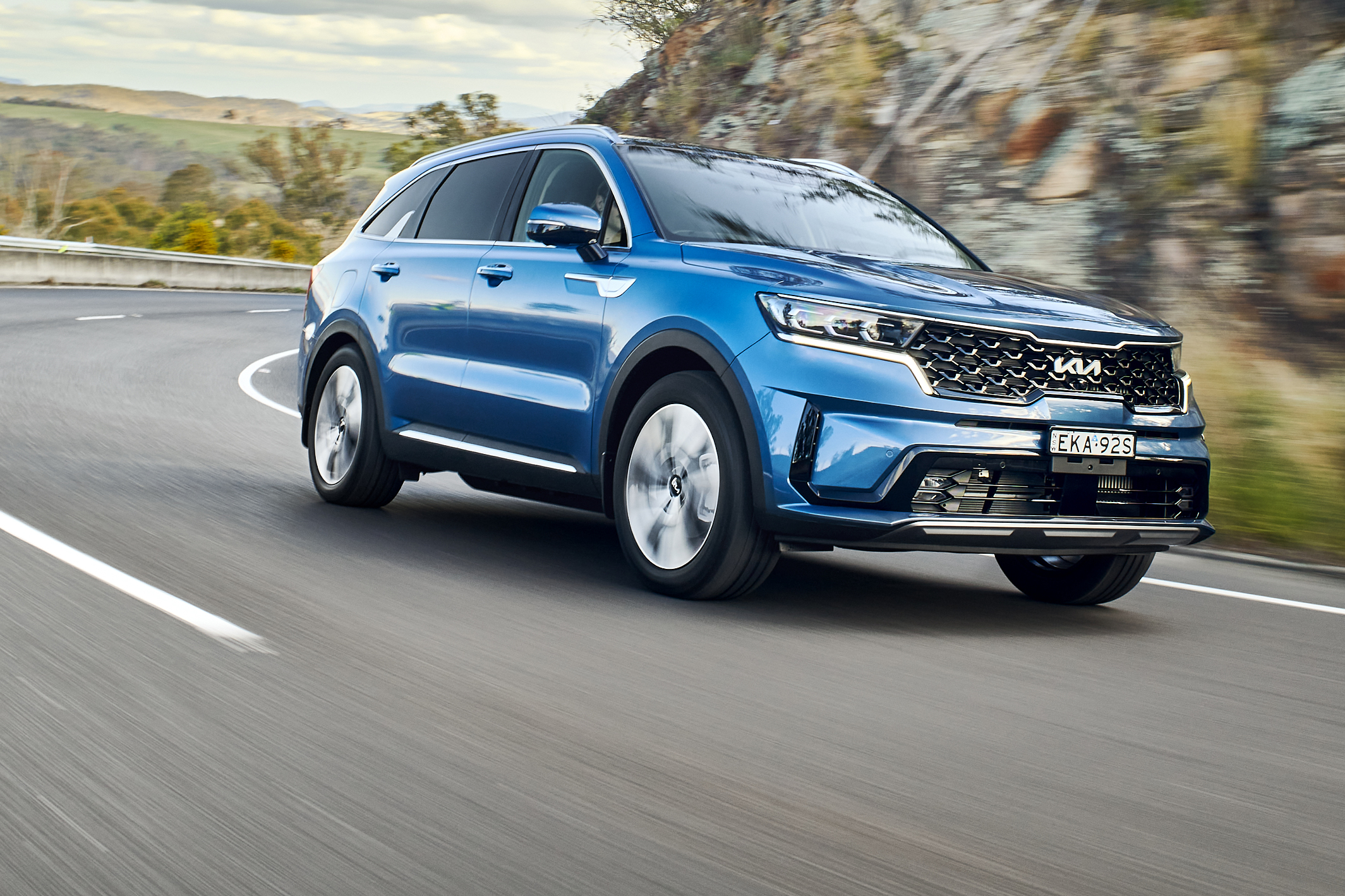Score breakdown
Things we like
- Efficient plug-in hybrid powertrain
- Loads of active safety tech
- Space and practicality
- Cabin fit and finish
Not so much
- Lack of more affordable spec options
- Slow battery charging rate
- Lower towing capacity
- Third row isn't adult friendly
When I reviewed the Kia Sorento Sport+ AWD, I boldly stated that opting for the turbo-diesel over the V6 petrol was a no-brainer, due to its superior fuel economy, superior pulling power and all-wheel-drive traction. But now there is a new petrol option of sorts that’s worth a second look.
Introducing the new plug-in hybrid version of Kia’s flagship seven-seat SUV, featuring a 1.6-litre turbocharged petrol engine and transmission-mounted electric motor that drives all four wheels and, on paper at least, is much more frugal than the diesel.
Unfortunately, there’s a catch. As you’d expect, the electrified powertrain comes at a considerably higher cost and that’s amplified by the fact it is only available in the range-topping GT-Line, resulting in retail pricing that nudges $80,000.
This makes the Kia Sorento GT-Line PHEV the most expensive Kia on the local market. However, and I don’t often say this about plug-in hybrids, there are a few things about it that may well justify the price hike.

What is Kia Sorento GT-Line PHEV like to live with?
The Sorento range features S, Sport, Sport+ and GT-Line variants that are each available with a 3.5-litre V6 petrol engine that drives the front wheels, or a torquey 2.2-litre four-cylinder turbo-diesel with all-wheel drive. Pricing starts at $49,850 before on-road costs for the petrol Sorento S, with the diesel AWD drivetrain attracting a $3000 premium.
At the other end of the scale, the V6 petrol and diesel GT-Line variants retail for $61,070 and $64,070 respectively, with the new GT-Line PHEV coming in at $79,330, (or $81,990 drive-away).
Ideally, there would be PHEV variants across the range, which would see pricing start around $65,000, but supply issues have meant that it will only be available in the range-topping spec for now.
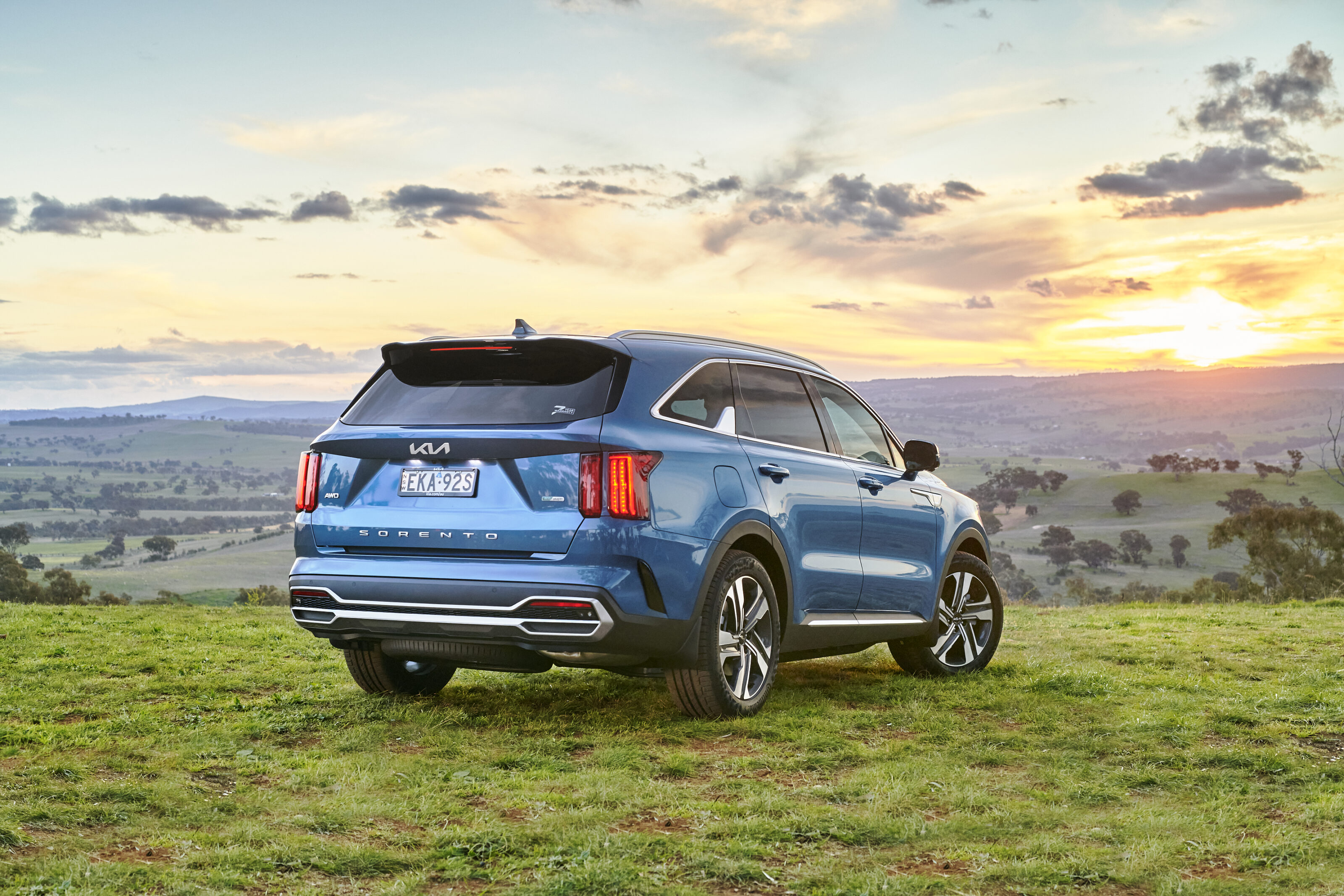
I don’t often say this about plug-in hybrids, there are a few things about this that may well justify the price hike.
As it happens, more than half of private Sorento buyers are opting for the GT-Line versions anyway and demand for the PHEV has already outstripped supply, meaning a six-to-eight month wait.
Being a GT-Line, the newest Sorento variant comes with the full kit and caboodle including stuff that would be extra-cost options in pricier models from premium brands, such as:
- A 12.3-inch high-definition digital dashboard
- 8.0-inch head-up display,
- 10.5-inch panoramic touchscreen
- Satellite navigation
- 360-degree parking camera
- Apple CarPlay/Android Auto
- DAB+ digital radio
- 12-speaker Bose premium sound system
- Quilted Nappa leather trim
- Heated and ventilated power-adjustable front seats
- Heated outboard second-row seats
- Heated leather-trimmed steering wheel
- Rotary gear shifter
- Powered tailgate
- Panoramic sunroof
- Interior mood lighting
- Smart engine remote start
- Fast wireless phone charger
- In-car intercom
- Dual-zone climate control.

Soft surfaces abound and while you’ll find hard plastics on the doors below the armrests, they don’t feel cheap or brittle.
The batteries don’t seem to impact comfort in the second row, which still offers plenty of leg and headroom. The seats are comfortable and can slide back and forth, while the backrests recline up to about 30 degrees.
Fitting three adults would be a bit of a squeeze, particularly on longer trips, but a low transmission tunnel means even the middle occupant can stretch their legs. There is more than enough space for three children, however, and the wide door opening helps make loading and strapping them in a breeze.

The middle row is serviced with air vents, map pockets behind the front seats, smallish door bins, cup holders cleverly installed in the door armrests, a fold-down centre armrest with additional cup holders, a 12-volt power socket and USB sockets mounted in the side of each front seat for easy reach.
The 60:40 split seats slide forward and fold down to provide third-row access with a single touch of a button, though climbing into the very back isn’t exactly an elegant exercise for anyone older than 12.
Indeed, the third row is best utilised by kids. Legroom is very tight for bigger people, even with the second-row seats pushed forward a couple of inches. There is nowhere to slide your feet and the seat is quite low, meaning taller people will almost have their knees touching their chin.
Another third-row downside is the lack of curtain airbag protection that’s enjoyed by the first and second rows.
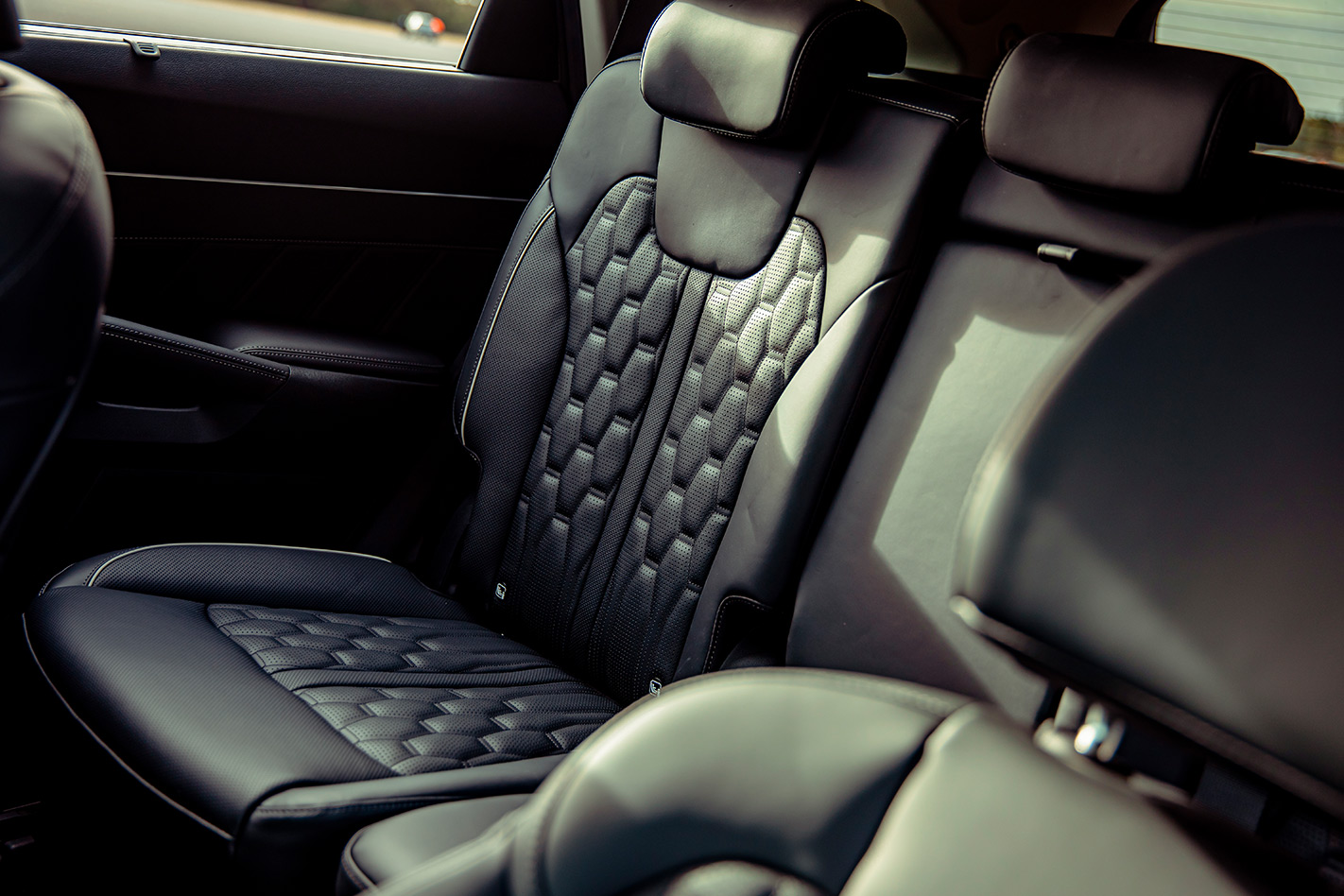
On the plus side, the GT-Line brings third-row passengers USB ports, cup holders, a small storage tub and a dial to control airflow through the rearmost vents.
Like most plug-in hybrid models, the need to fit batteries comes at the cost of luggage capacity, though in the case of the Sorento the difference is marginal.
Boot space with all three rows in use is 175 litres, which is enough to hold a stroller or the weekly shopping, and the third-row seats easily fold flat to bring a big 604-litre boot. In both cases, you’re only sacrificing 12 litres compared to the non-hybrid variants.
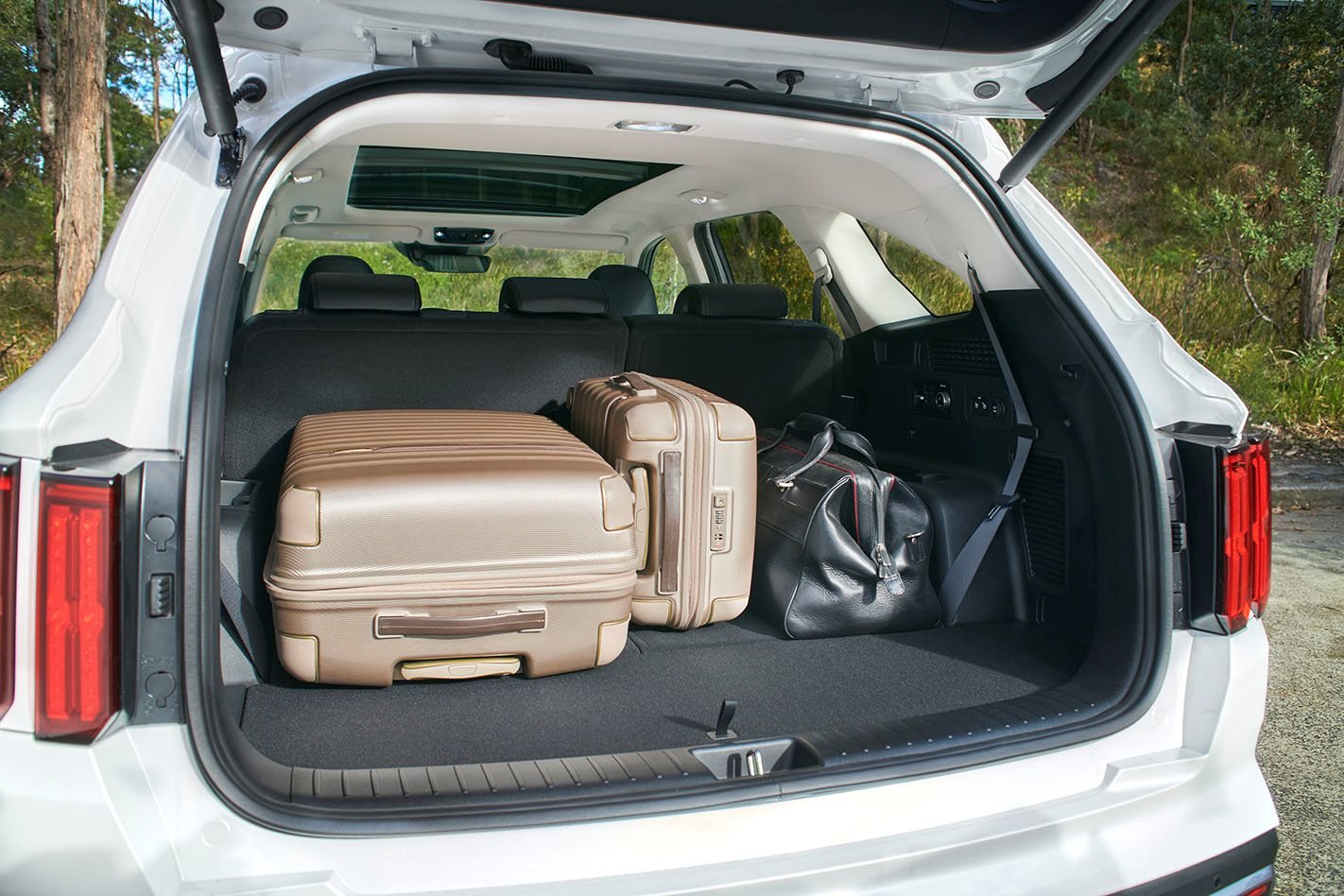
Folding the middle-row seats down allows you to carry up to 1988 litres of stuff, which is a 23-litre reduction. The boot blind and wheel jack are neatly stored under the boot floor, while the full-size spare wheel is stored underneath the Sorento so you can change a wheel without having to unload the kids or baggage – the GT-Line PHEV has 19-inch wheels instead of the 20s rolling under petrol and diesel versions.
Another difference is the braked towing capacity, which is 1350kg for the PHEV compared to 2000kg for the others, though the 750kg unbraked towing capacity is the same.
The Kia Sorento PHEV is covered by a seven-year/unlimited-kilometre warranty, with a separate seven-year/150,000km warranty covering the high-voltage electrical systems such as the battery, onboard charger, motor, and electric power control unit.
What is the Kia Sorento GT-Line PHEV’s powertrain like?
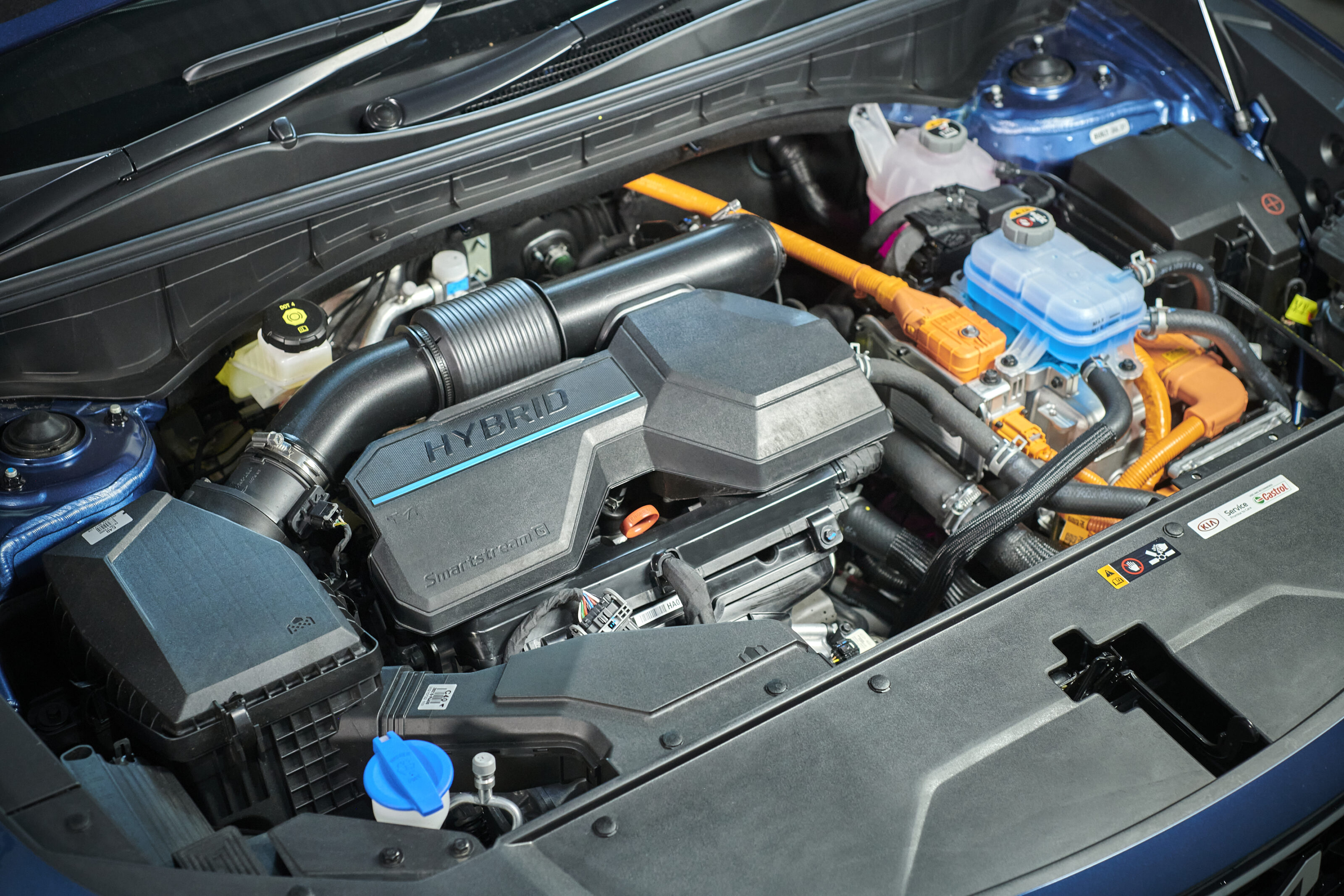
The Sorento PHEV is primarily powered by a 132kW/256Nm 1.6-litre, four-cylinder ‘Smartstream’ GDI petrol engine linked to a 67kW/304Nm electric motor.
The motor is mounted between the engine and six-speed transmission, contributing to a combined output of 195kW/350Nm to be transferred in parallel through the transmission to all four wheels when needed, making it the first petrol Sorento to be offered with AWD in Australia.
Power for the electric motor is drawn from a 14kWh lithium-ion polymer battery pack located under the vehicle floor, which allows the Sorento PHEV to travel up to 68kms (claimed) on electric power alone to help achieve an official combined fuel economy rating of just 1.6L/100km.

It uses the common Type 2 ‘Mennekes’ charging port, which can be connected to a standard 10-amp socket at home to fully charge the battery in six hours.
A dedicated AC charger can get that time down to four hours, or 3.25 hours if topping up from 15 to 95 per cent.
Unfortunately, the fastest rate the battery can be charged is 3.3kW even when using 7kW or 22kW AC chargers, which makes using public charges a little inconvenient unless you have something to do for more than three hours.
On the plus side, the battery is also charged by the engine at a rate of 3.3kW, meaning it never runs out of charge.
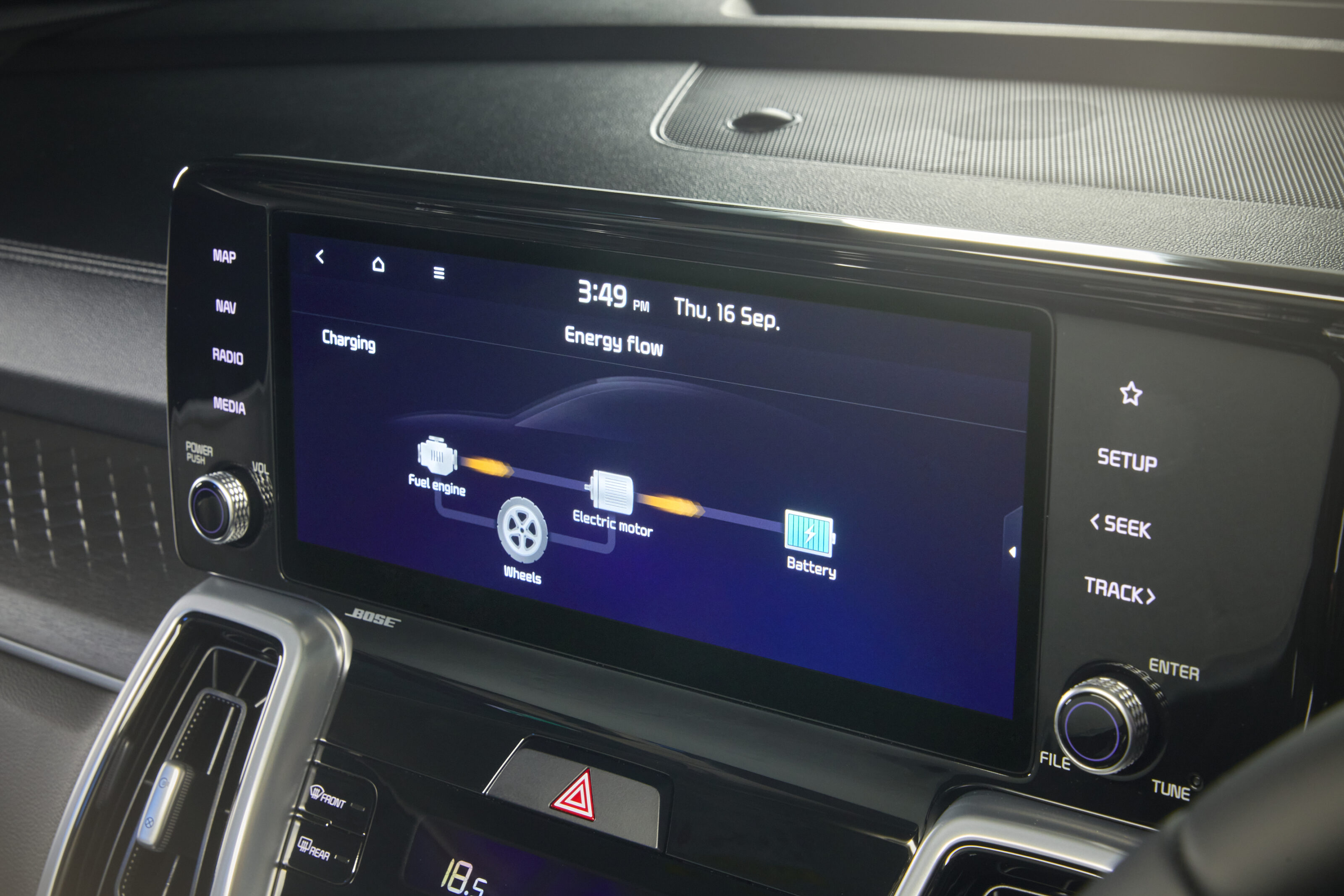
The Sorento PHEV offers different ways to drive efficiently. The best way to do that is in EV mode, which uses battery power alone for up to 68kms for pure emissions-free driving.
Alternatively, you can select HEV, which includes a Smart mode that operates as a normal hybrid vehicle and adapts to different driving conditions. Then there’s Sport mode, which combines engine and electric motor power for extra pep when you need it, albeit at the expense of fuel economy.
Unless you’re doing a relatively short trip it probably makes the most sense to drive in HEV Smart mode, even with a full battery, as it will default to battery power unless the engine is required for quicker driving or negotiating hills.
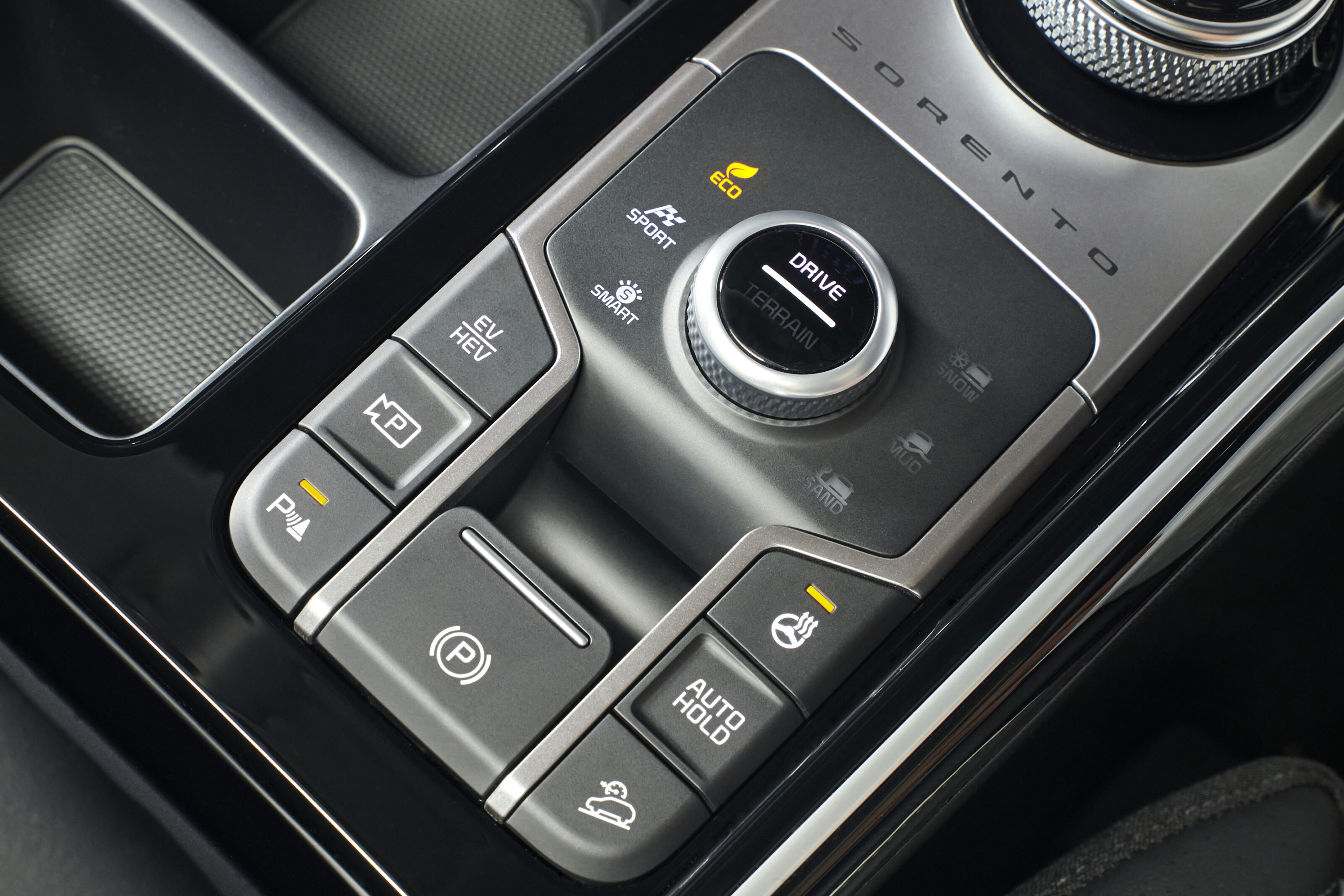
A good thing about Smart mode is it charges the battery while you drive so there is always enough power for the motor to take over in low-load situations such as cruising.
The effectiveness of this was demonstrated on an 85km testing loop I use that includes a freeway drive out to Melbourne’s northwestern outskirts, some semi-rural roads, another freeway hop and then 20km of solid urban driving.
I did this twice, the first time with the battery fully charged and finished with 84.3 kilometres behind me and fuel consumption of just 2.8L/100kms, which is incredible for a 2.0-tonne large SUV.
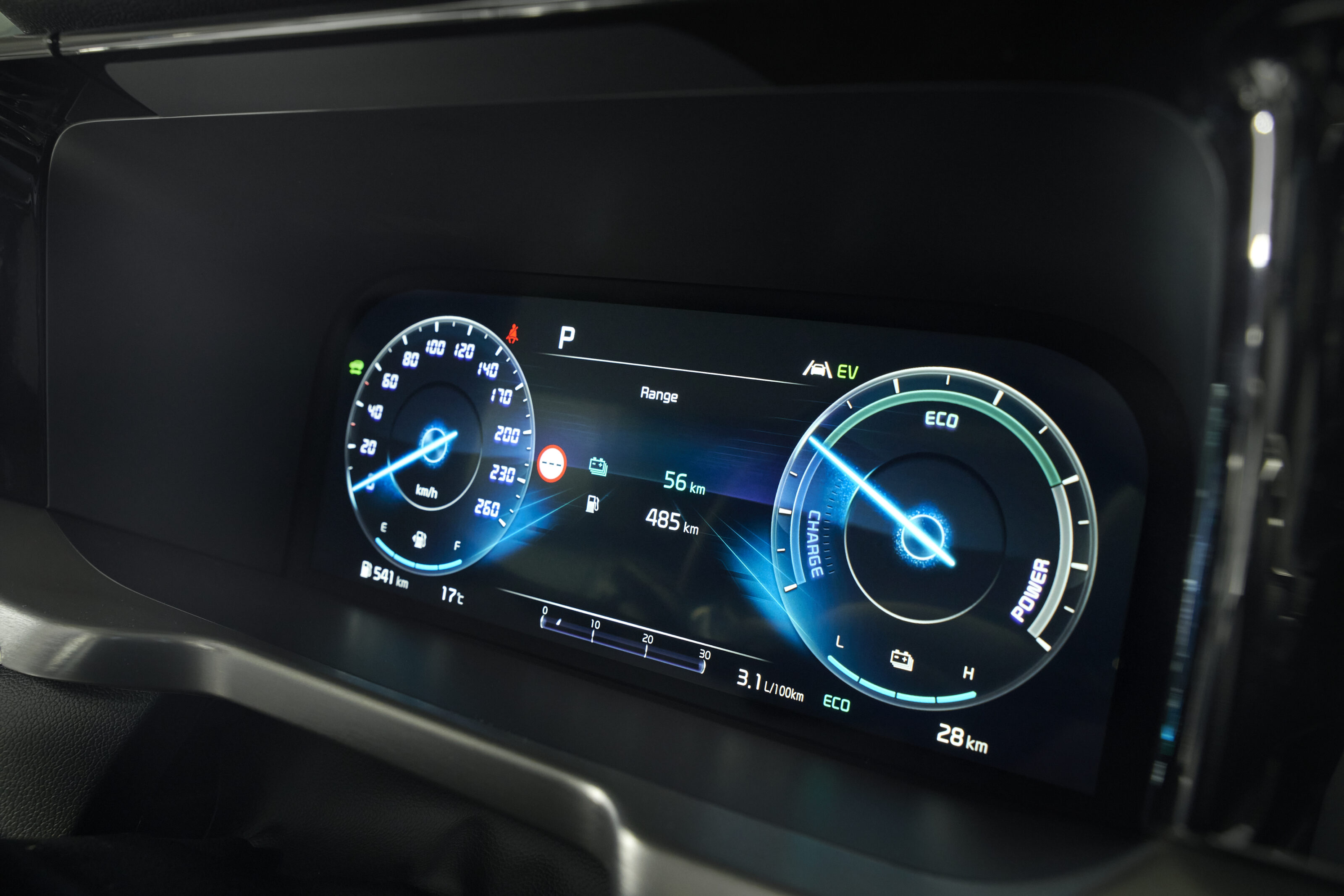
I embarked on the second loop with the minimum battery charge, which meant less EV driving than during the first hop.
Unfortunately, there was a roadblock near Sunbury that meant having to make a detour so by the time I returned home I had done 101.1kms with average fuel consumption of 6.7L/100km, which is almost half the V6 petrol Sorento’s real-world range and just over the ‘no-brainer’ diesel Sorento’s official 6.1L/100km consumption.
At the time of writing this, I had travelled 212.8kms at an average of just 5.8L/100km and with 515km worth of petrol still in the tank. This included some experimentation with Sport mode that at the time saw fuel consumption rise dramatically.

It’s all too easy to obsess about fuel consumption when driving a plug-in hybrid, but once you adopt a pragmatic approach to the fuel you’re saving, rather than what you’re using, you do appreciate the benefits.
What is the Kia Sorento GT-Line PHEV like to drive?
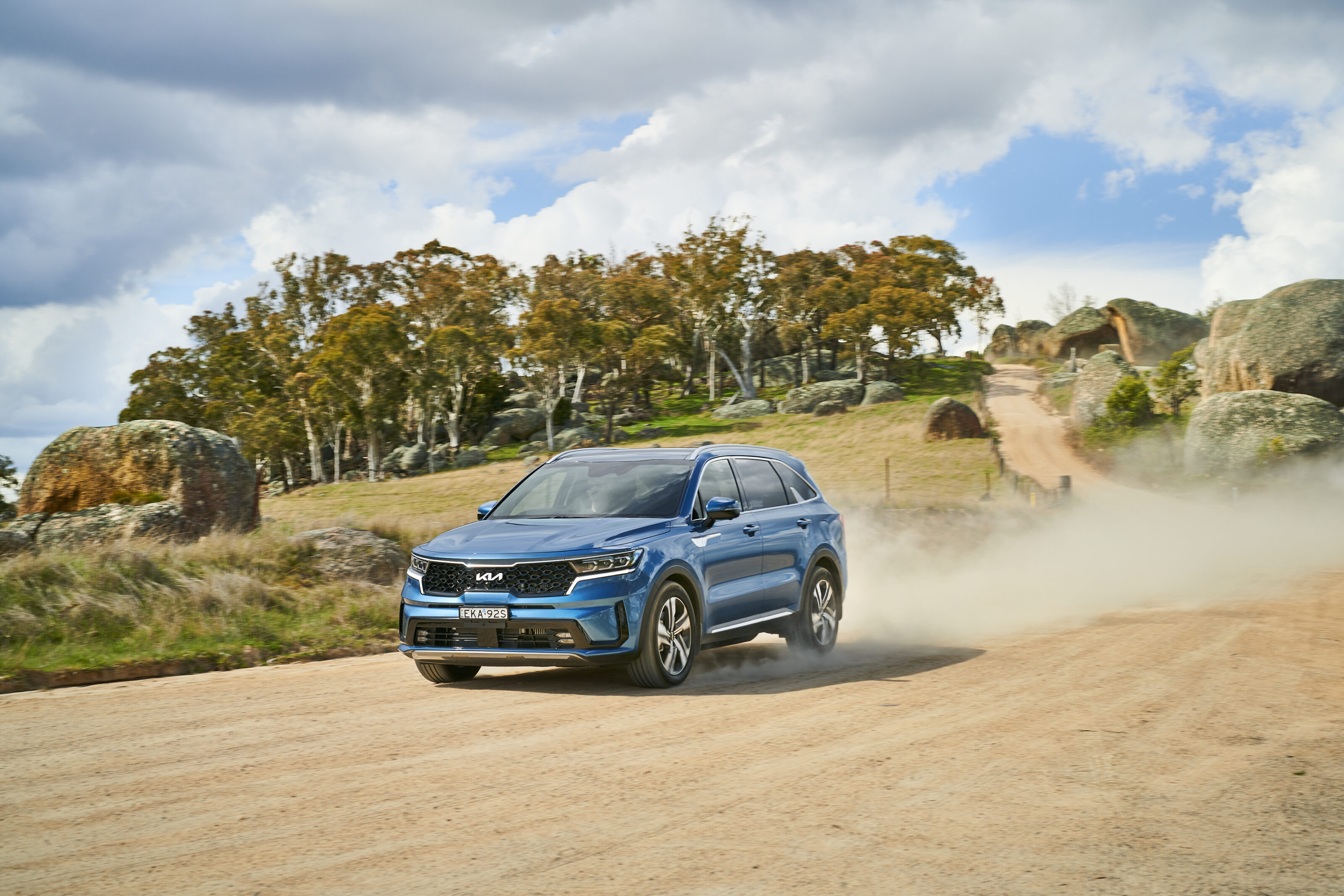
In hybrid mode, it’s not too dissimilar to driving the diesel and while it only weighs 48kg more, you do momentarily feel it when you put the foot down – even in EV mode, you don’t quite get that kick from the electric motor as the powertrain is tuned to prioritise efficiency over performance.
But once it gets going the hybrid powertrain has no problems pulling the Sorento’s heft or ensuring you have enough power for overtaking and the like.
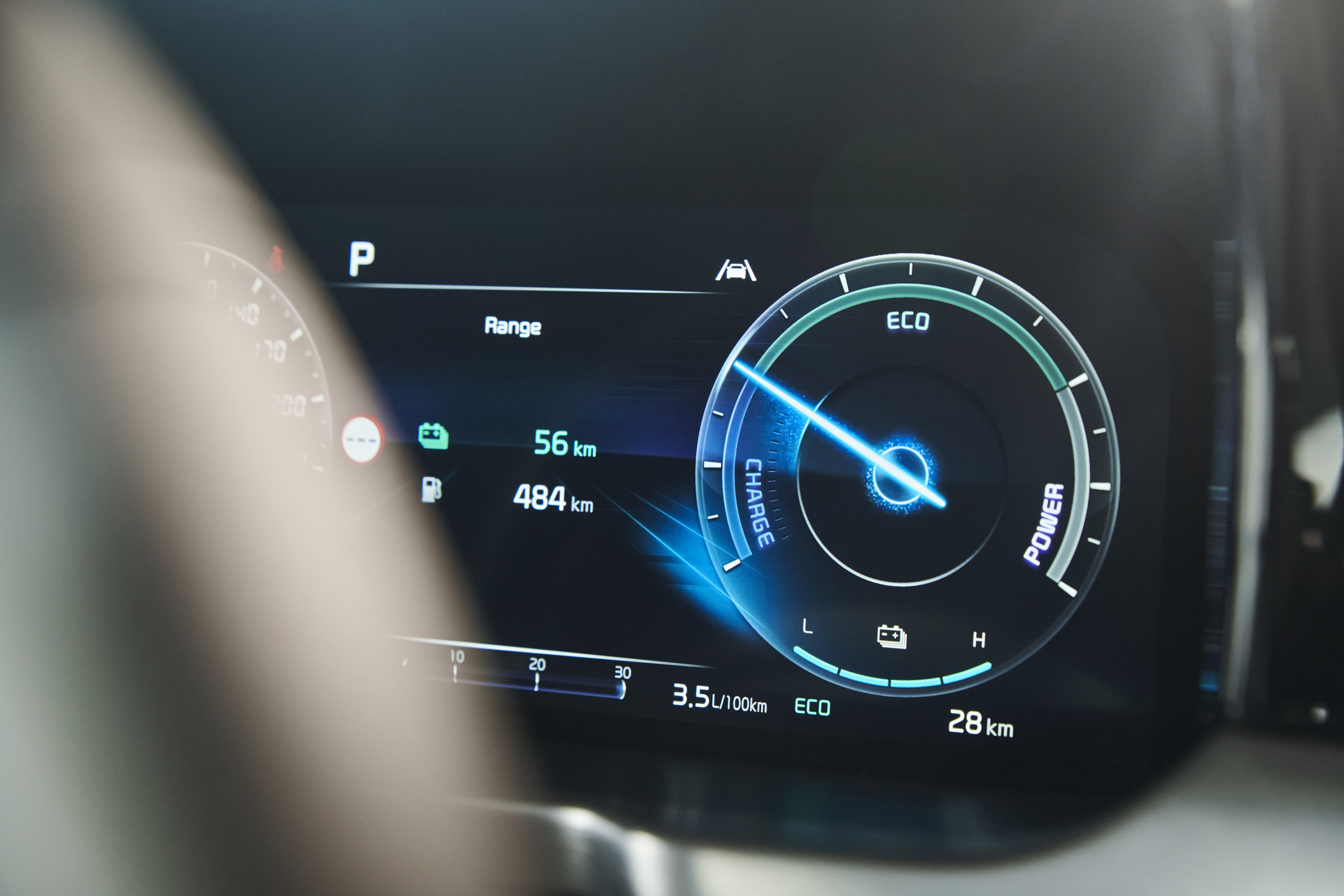
If you need, or feel like, some proper oomph, engaging Sport mode using the small dial on the centre console combines engine and motor power, which suddenly makes you feel like you’re driving an entirely different vehicle.
As well as boosting power, it adds additional weight to the steering for more precise cornering that makes you forget you’re driving a 4.8-metre three-row SUV.
You won’t exactly be saving the planet driving this way, but used sparingly, such as when driving through bendy hillsides, it doesn’t seem to have a significant impact on your overall fuel economy.
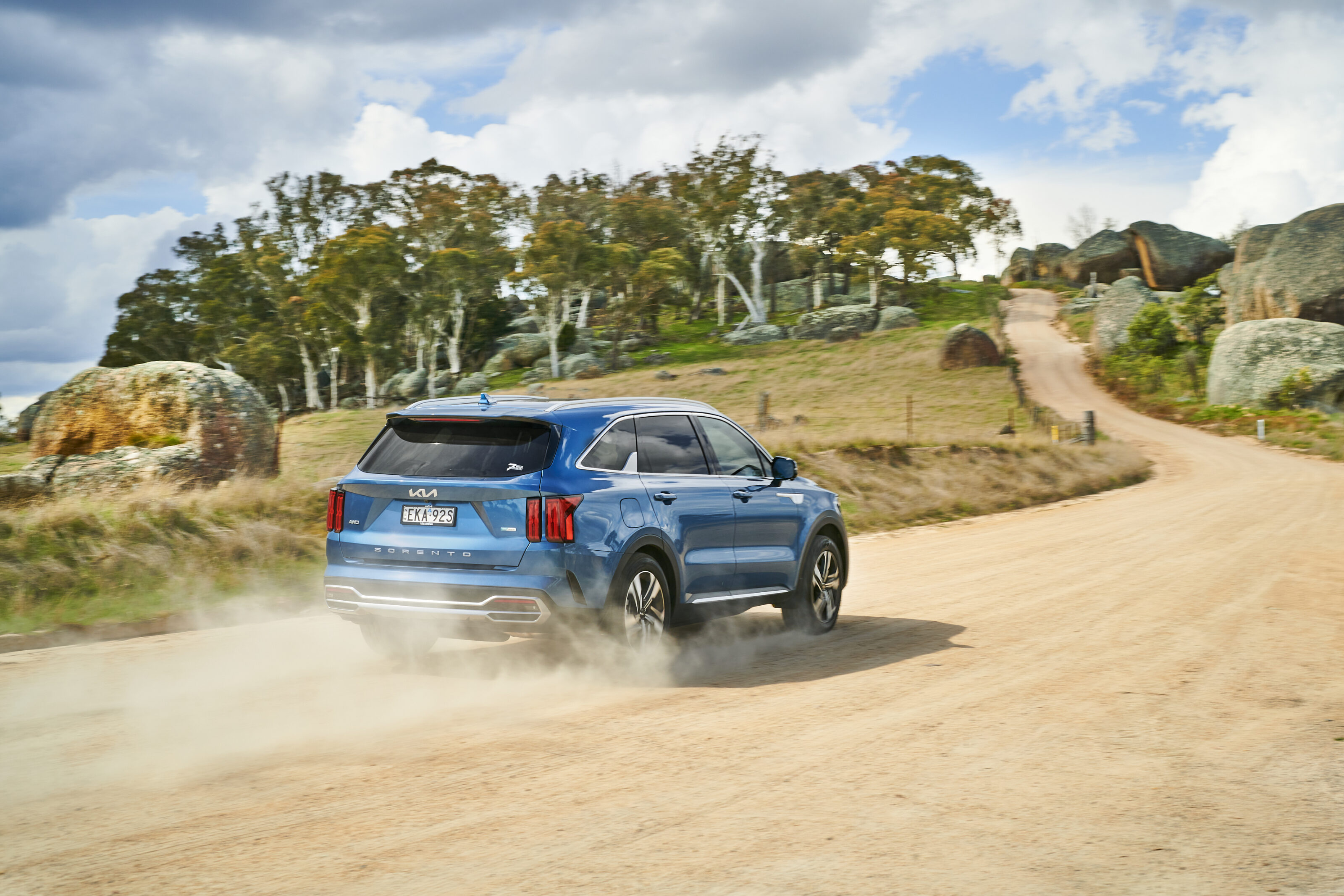
This has a six-speed automatic transmission instead of the excellent eight-speed dual-clutch in other Sorento powertrains, but there was always a seamless transition through gears in any driving mode.
Unlike the other Sorento variants, pandemic restrictions prevented the PHEV’s chassis from being tuned to suit Australian conditions, but this doesn’t seem to be an issue as it negotiates varied road surfaces very well. And despite its weight and size, it handles bends well too, with surprisingly little body roll.
Unlike the other GT-Line versions with 20-inch rims, this rides on 19-inch wheels and glides over smooth roads, with that feeling accentuated during all-electric silent running.
What is the Kia Sorento GT-Line PHEV like for safety?
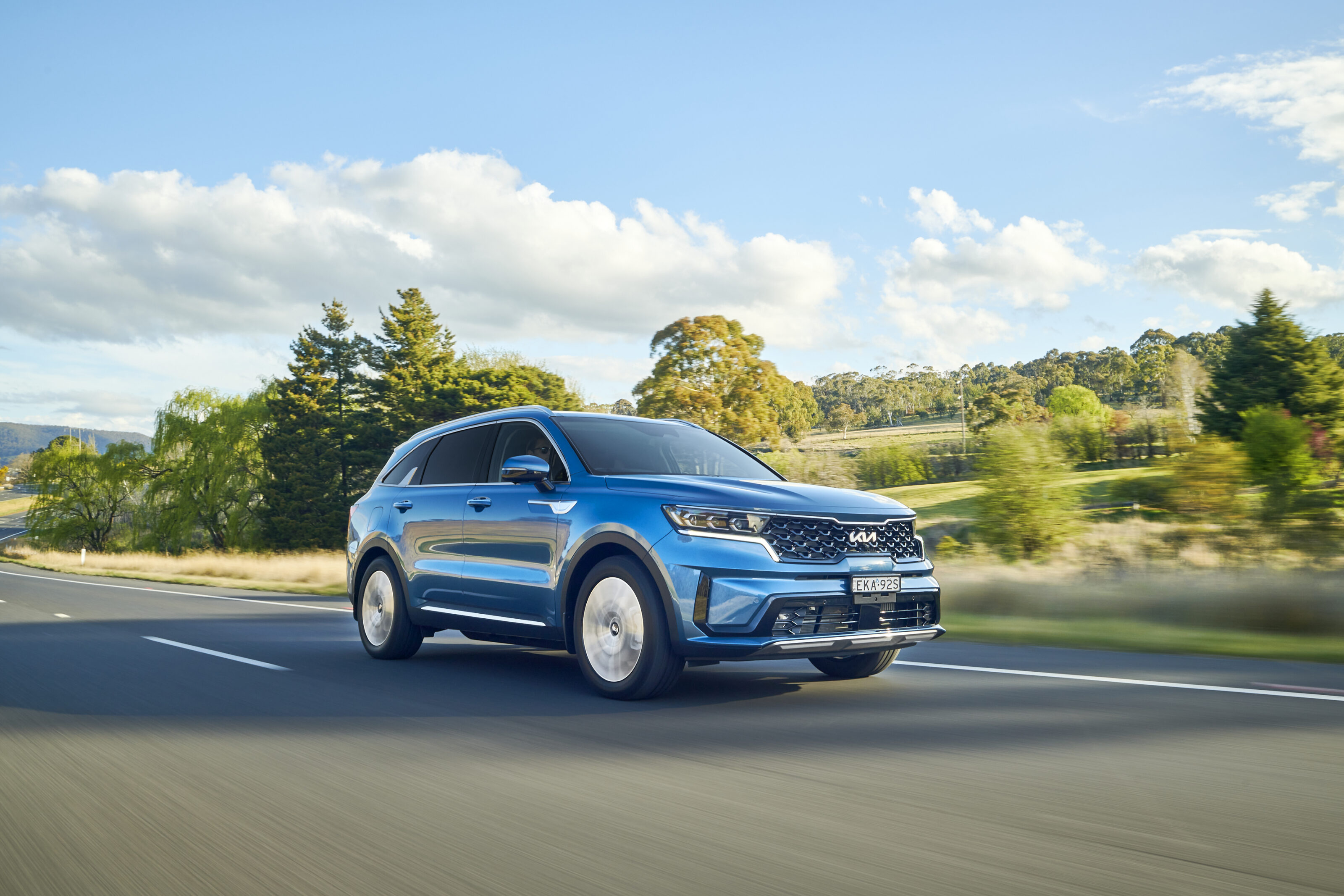
The Sorento’s driving experience is aided by a host of advanced driver assistance features including autonomous emergency braking (AEB) that can detect pedestrians and cyclists. The AEB also has junction detection, which can sense a vehicle entering an intersection from the side and apply the brakes if necessary.
Other advanced driver-assist features include lane-keeping assist, rear cross-traffic alert, driver attention alert, smart adaptive cruise control with stop-and-go function, and speed sign recognition.
The GT-Line spec also takes blind-spot collision avoidance further by flashing up a rearward side view of the vehicle on the digital gauge cluster when you indicate.
Also unique to this spec is the 360-degree parking camera and parking collision avoidance that automatically brakes if you’re about to hit something at low speed, including in reverse.

The Sorento has eight airbags: two directly in front of the driver and front passenger; one alongside each front occupant to protect the upper body and two more that pop up between the front seats to prevent occupants colliding with each other during impact.
As mentioned above, the curtain airbags that protect the heads of those riding in the front two rows do not extend to the third row, which is one of this car’s rare blemishes.
The Sorento PHEV shares the five-star ANCAP safety rating awarded to the rest of the range in July 2020.
The Verdict
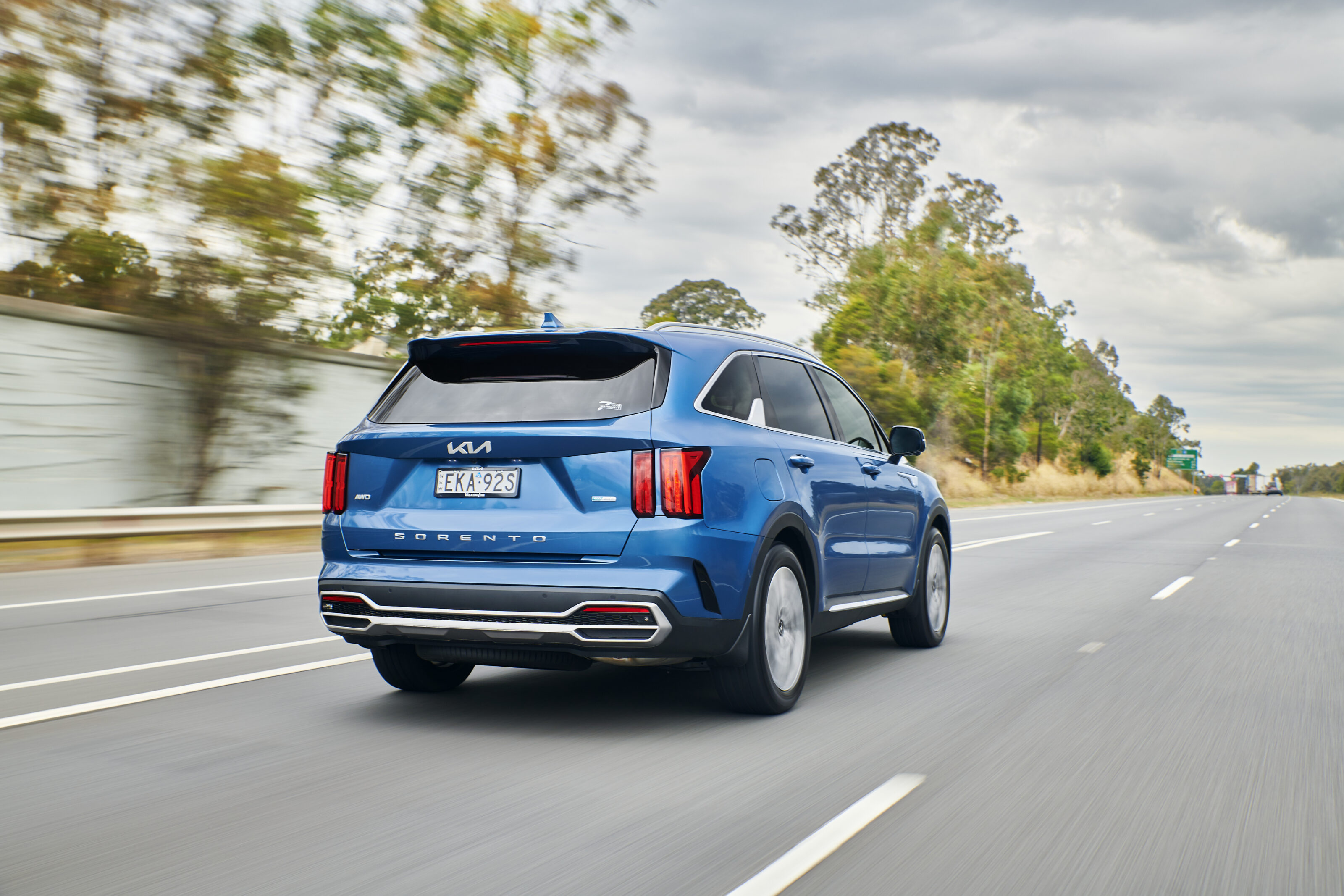
Plug-in hybrid powertrains make a lot of sense in big vehicles like this as the fuel savings are more dramatic.
This is certainly the case of the Sorento PHEV, where its superior efficiency over the petrol and diesel variants will be most keenly felt if do you do plenty of city driving and can charge it overnight.
If that suits your criteria and you can afford it then, unless you need to tow a huge caravan, I reckon this is the new no-brainer Sorento option that makes this very good large SUV even better.
However, its advantage over diesel is a little less dramatic if you’re mostly driving longer distances at highway speeds, which makes it a little more difficult to justify spending the extra $15K.
Another issue is that the 3.3kW maximum charging rate is too slow for convenient charging while on the go.
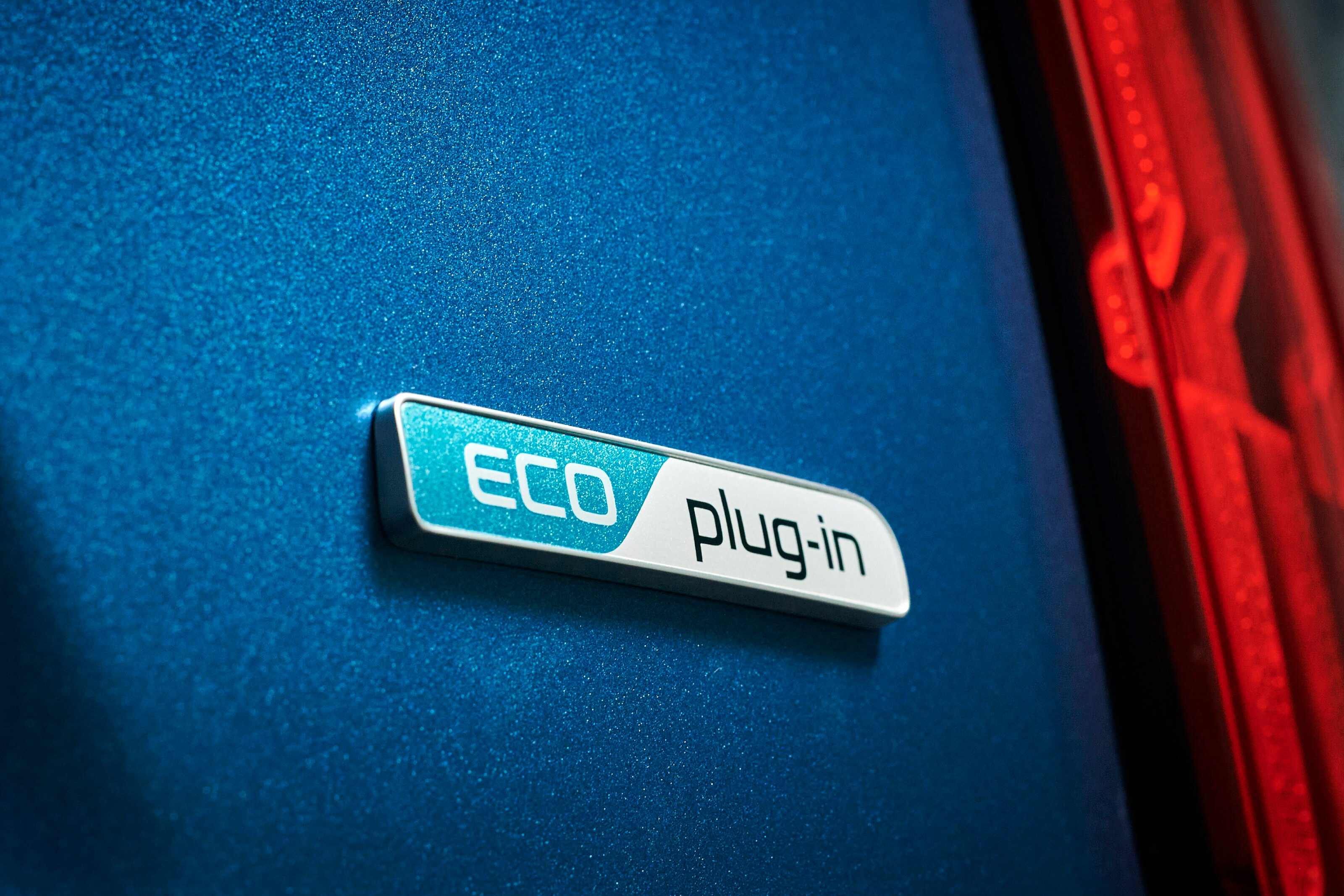
The good news is that a conventional hybrid (HEV) version of the Sorento is due to arrive at the end of November 2021, which is expected to have an official combined fuel economy of 5.4L/100km.
Apart from lacking a charging port, this powertrain is identical to the AWD PHEV’s but unfortunately, it will also share the same supply issues meaning it will only be available in GT-Line spec, and you may have to wait a while for one.
But it should be more affordable. Kia Australia hasn’t provided pricing yet, but if its Niro small SUV range is any guide, expect it to retail for about $71,000 before on-roads, which is a little less than the new Toyota Kluger Grande eFour Hybrid.
Kia Sorento GT-Line PHEV specifications
| Body | Five-door large SUV |
|---|---|
| Drive | All-wheel drive |
| Engine | 1.6-litre four-cylinder turbo plug-in hybrid |
| Transmission | 6-speed auto |
| Power | 132kW @ 5500rpm |
| Torque | 265Nm @ 5500rpm |
| Electric motor | 60kW/304Nm transmission-mounted |
| Combined power/ torque | 195kW/350Nm |
| Battery | Lithium-ion, 360V, 14kWh |
| Bore x Stroke | 75.6 x 89.0 |
| Compression ratio | 10.5:1 |
| 0-100km/h | N/A |
| Fuel consumption | 1.6L/100km |
| Weight | 2056kg (tare mass) |
| Suspension | MacPherson strut (front); Multi-link (rear) |
| L/W/h | 4810/1900/1700mm |
| Wheelbase | 2815mm |
| Brakes | 325mm Ventilated discs (front & rear) |
| Tyres | 235/55 R19 Continental Premium Contact 6 |
| Wheels | 19-inch alloys |
| Price | $79,330 RRP / $81,990 drive-away. |
Score breakdown
Things we like
- Efficient plug-in hybrid powertrain
- Loads of active safety tech
- Space and practicality
- Cabin fit and finish
Not so much
- Lack of more affordable spec options
- Slow battery charging rate
- Lower towing capacity
- Third row isn't adult friendly
We recommend
-
 News
News2022 Kia Sorento PHEV pricing and features
PHEV tech to be available in range-topping GT-Line guise only
-
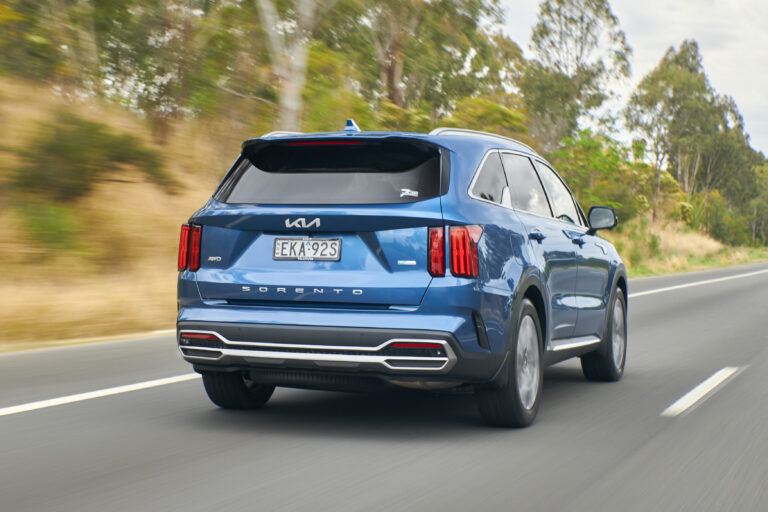 News
NewsKia Sorento hybrids hit with supply delays
The new Sorento PHEV and HEV are the latest electrified vehicles to face delays of up to eight months, with priority given to markets with stricter emissions laws


